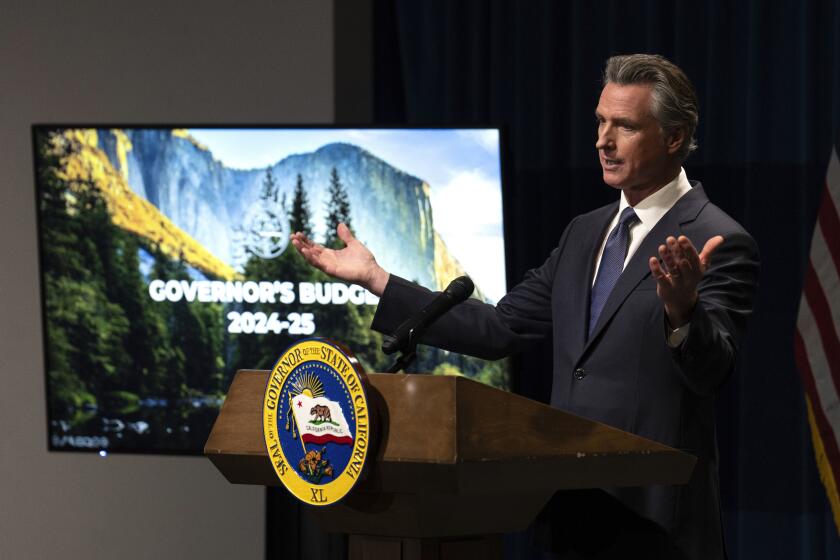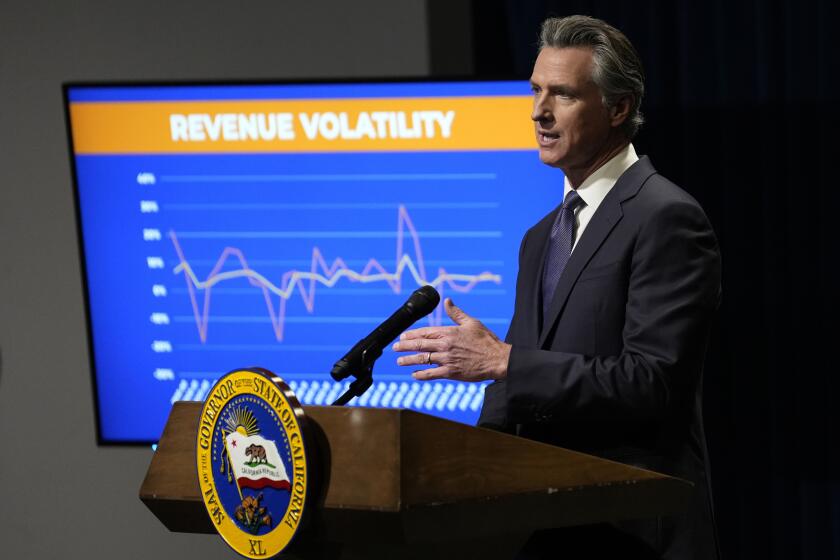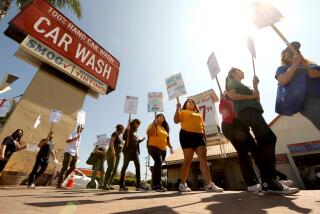Newsom and Democrats announce a plan to reduce the enormous budget deficit. How? TBD

- Share via
With a budget deficit of at least $38 billion hanging over their heads, Gov. Gavin Newsom and Democratic leaders of the state Senate and Assembly announced an agreement on Wednesday to take action in April to begin to dramatically reduce California’s historic shortfall.
The problem: Democrats at the state Capitol couldn’t actually agree on an amount — offering only a range of $12 billion to $18 billion — or explain what, exactly, they plan to cut.
Those details, the governor’s office said, will be discussed and shared next month.
The head-scratching announcement of a plan to have a plan comes as pressure mounts on Democrats over the looming fiscal crisis.
Newsom has urged the Legislature to take “early action” to begin to whittle away at the deficit now — well before the June deadline to pass a budget — by clawing back unspent funding, delaying programs and reducing planned spending. The cuts currently under discussion are largely considered the easier choices, with the hope of freeing up Democrats to focus on tougher deliberations that will come later this spring when the full scope of the budget hole becomes clearer.
The Senate unveiled its own plan last week to slice off $17 billion from the deficit with early cuts, which include delaying and pulling back more than $1 billion to expand early education classrooms and support school facilities. But the Assembly, where Democrats hold 62 of 80 seats under a new speaker who has promised to give his members more input on big decisions, has been slower to rally behind a plan.
The struggle to reach a real consensus on the early cuts speaks to the challenge ahead as Democrats embark on a process to correct what could be the largest fiscal deficit the state government has ever experienced. Some estimates suggest the shortfall could be nearly twice as much as Newsom’s estimates, which will force lawmakers to make difficult choices in May and June about programs that affect millions of Californians.
Democrats often pass an initial budget by the June 15 mandate required by state law and revise it again before the fiscal plan takes effect on July 15.
“In some ways, I think this forces an earlier reckoning of the reality of what they’re going to have to actually vote on,” said Rob Stutzman, a longtime GOP strategist who worked for Gov. Arnold Schwarzenegger. “And they’re going to wholly own it.”
With weaker revenues than expected, Gov. Gavin Newsom wants to declare a budget emergency and ask California lawmakers to dip into the state’s reserves.
Whereas Republicans shared the pain during the budget crisis in Schwarzenegger’s era, now Democrats control the governor’s office and both houses of the Legislature by wide margins.
Only a handful of lawmakers have experience in office during the prior budget crisis, and Newsom has never been forced to make cuts of this magnitude.
His call to shave the deficit early has been met with mixed responses from the Legislature, prompting Newsom to come to the Capitol this week for meetings with Democrats in the Senate and the Assembly leader in hopes of reaching an agreement before they leave Sacramento for spring break on Thursday. Lawmakers are expected to pass one of Newsom’s major budget proposals before the recess, a tax increase on managed-care organizations that allows the state to draw more federal funds for healthcare.
In a statement included in the announcement of the agreement, California Senate President Pro Tem Mike McGuire (D-Healdsburg) said the Senate is ready to move quickly on tough budget decisions.
“The deficit is serious and it’s grown by billions since January, which is why we must move with speed to shrink the shortfall immediately,” McGuire said.
The Senate’s plan to cut $17 billion, coupled with a desire to tap $12.2 billion from the rainy day fund, could leave lawmakers with $29 billion less to offset in June.
Newsom’s Department of Finance has said the governor’s administration backs the Senate’s package. But the Assembly has yet to detail how it wants to move forward.
What do voters think about the governor and potential solutions to the state’s looming budget deficit?
The budget chair of the lower house, Assemblymember Jesse Gabriel (D-Encino), held a news briefing on Friday and said the Assembly appreciated the proposals from the governor and Senate, but also needed more time.
“We value process and we value time to consider all of these trade-offs,” Gabriel said.
Gabriel said the Assembly planned to put forth its proposal in April. He said he could foresee the Assembly taking some early action but he also saw advantages to waiting until June to have more certainty about the size of the shortfall.
In a statement released Wednesday with the vague announcement of a forthcoming agreement, Assembly Speaker Robert Rivas (D-Hollister) hailed it as “an important first step” and said “the Assembly is committed to a deliberative, transparent budget process that protects hard-working Californians.”
But the lack of details in the announcement about the cuts that Democratic leaders are considering is an example of the complete opposite, said Sen. Roger W. Niello, a Republican from Fair Oaks and vice chair of the Senate Budget Committee, in a statement. He called it “unilateral decision-making happening behind closed doors by one political party.”
More to Read
Sign up for Essential California
The most important California stories and recommendations in your inbox every morning.
You may occasionally receive promotional content from the Los Angeles Times.













